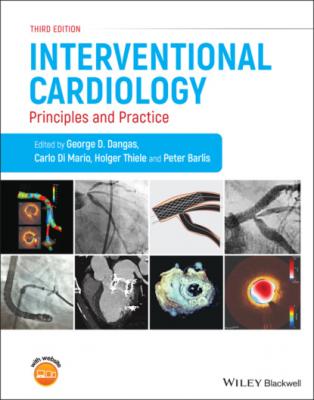Interventional Cardiology. Группа авторов
Читать онлайн.| Название | Interventional Cardiology |
|---|---|
| Автор произведения | Группа авторов |
| Жанр | Медицина |
| Серия | |
| Издательство | Медицина |
| Год выпуска | 0 |
| isbn | 9781119697381 |
Table 11.1 Optimal secondary prevention in stable coronary artery disease.
| Risk factor | Goal/recommended intervention |
|---|---|
| Lipid management | The optimal goal of treatment is to lower LDL‐C by at least 50% from baseline and to <1.4 mmol/L (<55 mg/dL) although a lower target LDL‐C of <1.0 mmol/L (<40 mg/dL) may be considered in patients who have experience a second vascular event within 2 years. Statins are recommended in all patients. If treatment goal not reached, then add ezetimibe, and if that fails, combination with a PCSK9 inhibitor is recommended. |
| Blood pressure control | It is recommended that office BP is controlled to target values: systolic BP 120–130 mmHg in general and systolic BP 130–140 mmHg in older patients (aged >65 years). Beta‐blockers and ACE‐inhibitors/angiotensin receptor blockers preferred) |
| Diabetes management | Hemoglobin A1C <7.0% Lifestyle modification ± drug therapy |
| Smoking | Complete cessation. No environmental exposure. Use pharmacological and behavioral strategies to help patients quit smoking. |
| Weight management | Body mass index 18.5–24.9 kg/m2, waist circumference: men <40 inches (<100 cm), and women <35 inches (88 cm) Regular physical exercise and restrict caloric intake |
| Physical activity | 30–60 minutes of moderate‐intensity aerobic activity, such as brisk walking most days, but even irregular activity is beneficial |
Figure 11.1 Suggested stepwise strategy for long term anti‐ischemic drug therapy in patients with chronic coronary syndromes and specific baseline characteristics. The proposed stepwise approach must be adapted to each patient’s characteristics and preferences. Given the limited evidence on various combinations of drugs in different clinical conditions, the proposed options are only indicative of potential combinations and do not represent formal recommendations. BB, beta‐blocker; bpm, beats per minute; CCB, [any class of] calcium channel blocker; DHP‐CCB, dihydropyridine calcium channel blocker; HF, heart failure; LAN, long‐acting nitrate; LV, left ventricular; non‐DHP‐CCB, non‐dihydropyridine calcium channel blocker. aCombination of a BB with a DHP‐CCB should be considered as first step; combination of a BB or a CCB with a second‐line drug may be considered as a first step; bThe combination of a BB and non‐DHP‐CCB should initially use low doses of each drug under close monitoring of tolerance, particularly heart rate and blood pressure; cLow‐dose BB or low‐dose non‐DHP‐CCB should be used under close monitoring of tolerance, particularly heart rate and blood pressure; dIvabradine should not be combined with non‐DHP‐CCB; eConsider adding the drug chosen at step 2 to the drug tested at step 1 if blood pressure remains unchanged.
Source: Knuuti et al 2020 [4]. Reproduced by permission of Oxford University Press.
Guidelines on the management of stable angina
The most recent guidelines on the management of stable angina have been published by the European Society of Cardiology in 2019 [4] in which the term chronic coronary syndromes is used to include patients with stable angina due to obstructive disease as well as coronary spasm and microvascular dysfunction. Earlier guidelines include those by the American College of Cardiology (ACC) and the American Heart Association (AHA) in 2012 [5]. Additional relevant guidelines include the 2018 ESC/EACTS Guidelines on myocardial revascularization (Tables 11.2 and 11.3) [6], and the ACCF/AHA/ SCAI 2011 Guideline for Percutaneous Coronary Intervention [7]. These guidelines are evidence based and should be the basis for clinical practice. However, there are several fundamental limitations of the trial data available on the management of stable angina. First, as with many clinical trials, the rigorous inclusion and exclusion criteria have resulted in a relatively small number of the screened patients being enrolled into the studies. This significantly limits the ability to generalize the findings to the larger population in daily practice. Moreover, clinical trials have generally excluded high risk patients with severe angina, severe atherosclerosis, severely reduced left ventricular (LV) systolic function, or multiple comorbid conditions. Second, the findings of clinical trials comparing treatment strategies often become outdated quickly because of the rapid evolution in clinical practice.
Table 11.2 ESC Guideline indications for revascularization in patients with stable angina or silent ischemia.
| Extent of CAD (anatomical and/or functional) | Classa | Levelb | |
|---|---|---|---|
| For prognosis | Left main disease with stenosis >50%c | I | A |
| Proximal LAD stenosis >50%c | I | A | |
| Two‐vessel or three‐vessel disease with stenosis >50%a with impaired LV function (LVEF ≤35%)c | I | A | |
| Large area of ischemia (>10% of LV) or abnormal FFRd | I | B | |
| Single remaining patent with coronary artery stenosis >50%c | I | C | |
| For symptoms | Hemodynamically significant coronary stenosis in the presence of limiting angina or angina equivalent, with insufficient response to optimized medical therapy.e | I | A |
CAD, coronary artery disease; FFR, fractional flow reserve; iFR, instantaneous wave‐free ratio; LAD, left anterior descending coronary artery; LV, left ventricular;
LVEF, left ventricular ejection fraction.
a Class of recommendation.
b Level of evidence.
c With documented ischaemia or a hemodynamically relevant lesion defined by FFR <_0.80 or iFR <_0.89, or >90% stenosis in a major coronary vessel.
d Based on FFR <0.75 indicating a prognostically relevant lesion (see section 3.2.1.1).
e In consideration of patient compliance and wishes in relation to the intensity of anti‐anginal therapy.
Source: Neumann et al. 2019 [6]. Reproduced by permission of
